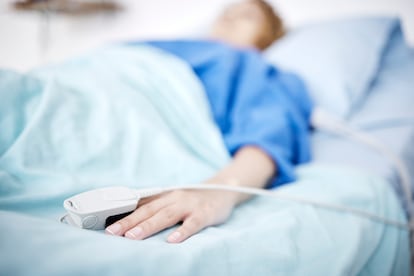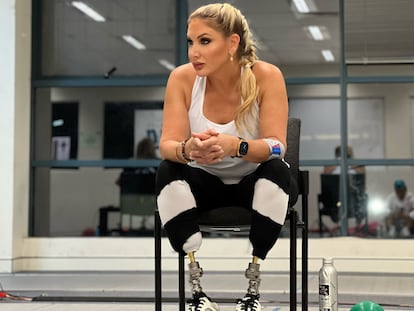A quarter of coma patients still have some form of consciousness
A study found that some individuals in a vegetative state have brain activity similar to that of healthy people who imagine playing tennis

Neuroscientist Ignacio Morgado says that years ago he met a young man, aged around 25, who had been in a motorcycle accident. “He was sitting, eating, drinking, urinating, sleeping and waking up, but he didn’t communicate with anyone,” he explains. “I was never sure if this guy was conscious but couldn’t communicate, or if he wasn’t conscious,” he recalls. The young man’s problem was similar to that of many others who, after an illness or an accident, are bedridden, in a vegetative state, sometimes with their eyes open and moving from time to time, but unable to make a gesture to confirm that they are listening when someone speaks to them.
An international team of scientists has just published a study with 241 patients in various hospitals and has concluded that one in four have some degree of consciousness. The work, published in The New England Journal of Medicine, is an effort to answer an anguishing question for those people who have a loved one in such a condition: do they hear me when I speak to them? Do they know that we are here? These patients sometimes regain consciousness, but often remain in a coma for years or even decades. “There is a very distressing question for families, which is whether they should turn off life support,” says Morgado.
At six research centers, researchers measured the brain activity of patients, seemingly oblivious to their surroundings, when they were asked to imagine themselves doing things such as playing tennis. In about one in four, their brains produced signals similar to those produced by healthy people when asked to do the same thing, and in the same brain regions — interpreted as a sign that they retain some degree of consciousness.
This was not the first time that a study of this type had been carried out. Adrian Owen, one of the authors, says in a note posted by the University of Western Ontario — where he works — that he began to see brain activity in vegetative patients in the mid-1990s, back when he worked in Cambridge University. “We showed them pictures and played them tapes of people speaking and bits of their brain would light up, but we couldn’t get beyond, ‘Well, that’s very interesting. But are they conscious?’” he says. “Then I just had this Eureka moment where I realized what we needed to do was to get somebody to do something that can’t be an automatic reflex.” This type of command lit up two unique parts of the brain during a functional magnetic resonance imaging, both in healthy and vegetative patients. The researchers published their results in an article in the journal Science in 2007.
Since then, many researchers have found similar results, adding ways to measure brain signals, such as using an electroencephalogram (EEG). However, in the new study, the percentages of patients who showed signs of consciousness were somewhat lower than those recorded in the 2007 work. In the new study, the researchers wanted to obtain more conclusive results, and involved a larger number of patients — including some who had taken part in previous studies — from several different hospitals, who were tested at the same time.
“Until recently we thought that the figure was between 15% and 20% of patients. It could be more, but the detail is not so important; it is a significant percentage of patients that must be taken into account,” says Davinia Fernández-Espejo, from the University of Birmingham, who studies consciousness issues caused by brain injuries.
For these tests to be done routinely in hospitals, Fernández-Espejo believes they need to be standardized, along with the parameters that are measured and the analyses, “so that it does not matter if you apply the test in Spain or in the U.S. or in one hospital or another.” The next issue would be to determine how to use the information to improve patient treatment. “We are working with a private hospital in London on the development of brain stimulation techniques for rehabilitation in patients who we see are conscious and to try to act on the motor pathways and see if we can help them to regain some control over movement,” she explains.
Her team proposed an explanation for why these apparently conscious people cannot communicate with the outside world. “We found some fibers that connect an area of the brain called the thalamus, inside the brain, with the parts of the cerebral cortex that regulate movement,” says Fernández-Espejo. This disconnection — which is only seen in patients who are conscious but cannot move voluntarily, only spontaneously — led them to consider a possible therapy. “We want to activate the few neurons that should connect these two areas, with electrical stimulation, to restore the patient’s mobility,” she says.
Researchers are now considering whether brain implants could be used to better understanding the characteristics of patients who are conscious but unable to communicate, in the same way they have helped ALS patients in a completely locked-in state regain a certain degree of communication. Nicholas Schiff, co-author of the study, believes that some of these patients could benefit from this type of implant.
However, although the tasks used in studies such as the one published in The New England Journal of Medicine indicate that the attention, linguistic comprehension and memory capacity of a quarter of vegetative patients may be intact, it is only a snapshot of the patients’ responses during the experiment, and the capacities of people in vegetative states vary widely.
“During the rest of the day there may be a fluctuation, sometimes they are more or less alert and, in fact, this is what we usually see in these patients,” explains Fernández-Espejo. “It is difficult to establish techniques to know their internal experience, to carry out a psychological examination, for example.”
One of the dilemmas surrounding patients with these brain injuries is whether they should be given the choice of continuing to live or not. The researcher from the University of Birmingham explains that right now “we are limited to asking yes or no questions, which take five minutes to get an answer.” “Theoretically, it could be done, but it is very difficult, and at the moment we are focusing on questions that can help us improve their quality of life,” she says.
While news that some people in a vegetative state are conscious may bring hope to their family and friends, it doesn’t mean they will recover or that they can be treated to recover. What goes on in the minds of others, even if they can express themselves, is a mystery far from being solved. Still, knowledge can provide benefits. Owen believes that for the patient’s loved ones, it may be harder to know that they are conscious but unable to communicate, than for them to be unaware of their condition. “This is not the case generally,” he explains, “the opposite is usually true.” Most people like to know that the person they thought was lost is still in there, even if they can’t communicate with them.
Sign up for our weekly newsletter to get more English-language news coverage from EL PAÍS USA Edition
Tu suscripción se está usando en otro dispositivo
¿Quieres añadir otro usuario a tu suscripción?
Si continúas leyendo en este dispositivo, no se podrá leer en el otro.
FlechaTu suscripción se está usando en otro dispositivo y solo puedes acceder a EL PAÍS desde un dispositivo a la vez.
Si quieres compartir tu cuenta, cambia tu suscripción a la modalidad Premium, así podrás añadir otro usuario. Cada uno accederá con su propia cuenta de email, lo que os permitirá personalizar vuestra experiencia en EL PAÍS.
¿Tienes una suscripción de empresa? Accede aquí para contratar más cuentas.
En el caso de no saber quién está usando tu cuenta, te recomendamos cambiar tu contraseña aquí.
Si decides continuar compartiendo tu cuenta, este mensaje se mostrará en tu dispositivo y en el de la otra persona que está usando tu cuenta de forma indefinida, afectando a tu experiencia de lectura. Puedes consultar aquí los términos y condiciones de la suscripción digital.
More information
Archived In
Últimas noticias
The metaverse, four years later: Is it finished or just at a standstill?
$3,000 and a plane ticket: The United States increases incentives for migrants to self-deport before the end of the year
Charles Dubouloz, mountaineering star, retires at 36 with a farewell tour inspired by Walter Bonatti
From the White House to diplomatic gifts: Lego wins over adult fans, brick by brick
Most viewed
- The low-cost creative revolution: How technology is making art accessible to everyone
- Christian Louboutin: ‘Young people don’t want to be like their parents. And if their parents wear sneakers, they’re going to look for something else’
- All the effects of gentrification in one corner of Mexico’s Colonia Roma
- Christmas loses its festive spirit: ICE fears cast shadow over religious celebrations
- Liset Menéndez de la Prida, neuroscientist: ‘It’s not normal to constantly seek pleasure; it’s important to be bored, to be calm’











































